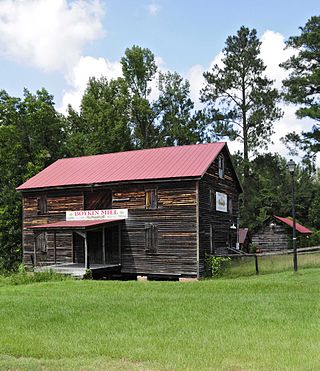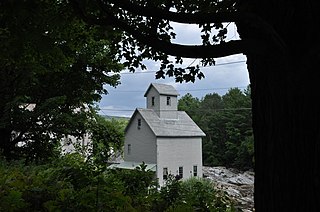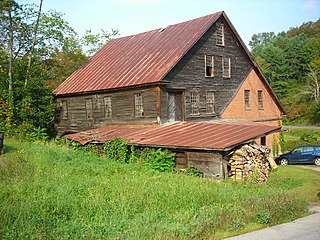
Wakefield is a village in the town of South Kingstown, Rhode Island, United States, and the commercial center of South Kingstown. Together with the village of Peace Dale, it is treated by the U.S. Census as a component of the census-designated place identified as Wakefield-Peacedale, Rhode Island. West Kingston, another South Kingstown village, was the traditional county seat of Washington County. Since 1991, the Washington County Courthouse has been in Wakefield. The Sheriff's Office which handles corrections is also in Wakefield.

Bradley's Country Store Complex is located 12 miles (19 km) north of Tallahassee, Florida, United States on Centerville Road in the community of Felkel, Florida. Bradley's Country Store complex has 17 buildings, most frame vernacular, on 31 acres (130,000 m2) of land.

Kirby's Mill is a historic grist mill in Medford, Burlington County, New Jersey, United States. Originally known as Haines Mill, it was built in 1778 by Isaac Haines and partners along the Southwest Branch of Rancocas Creek. It was the last commercial operating mill in New Jersey.

Harrisville Historic District is a well-preserved historic New England mill village located in the southwest part of New Hampshire. It consists of about 200 acres (0.81 km2) and about 135 structures. It was declared a National Historic Landmark in 1977.

Lewis Mill Complex is a historic grist mill complex located at Jefferson, Frederick County, Maryland. The complex consists of seven standing structures, a house foundation, and the remains of an earlier millrace. It centers on an early 19th-century three-story brick mill structure with a gabled roof. The mill complex served German immigrant farmers in Middletown Valley between 1810 and the 1920s. It was rehabilitated in 1979-1980 for use as a pottery shop. Also in the complex are a stuccoed log house and log springhouse built about; a frame wagon shed and corn crib structure and frame barn dating from the late 19th century; and early 20th century cattle shelter and a frame garage.

Jerusalem Mill Village is a living history museum that spans the 18th through early 20th centuries. One of the oldest and most intact mill villages in the U.S. state of Maryland, Jerusalem is located in Harford County, along the Little Gunpowder Falls River. It also serves as the headquarters of the Gunpowder Falls State Park. The site was added to the National Register of Historic Places on August 20, 1987. Also on the National Register of Historic Places and located nearby are Jericho Farm and the Jericho Covered Bridge.

The Central Mills Historic District encompasses a historic mill complex on the Quinebaug River in central Southbridge, Massachusetts. Located at the corner of Foster and North Streets, the site consists of three brick buildings, the oldest of which has portions dating to 1837. Despite being extensively rebuilt in the early 20th century, the complex has an appearance that is more typical of 19th century mills.

Muddy Creek Mill is a historic grist mill complex and national historic district located in Tamworth, Cumberland County, Virginia. The district encompasses five contributing buildings and three contributing sites. The mill was built between 1785 and 1792, and is a large two-story structure with two half stories and rests on a down slope basement. It is constructed of sandstone, rubble masonry, and brick. Associated with the mill are a contributing brick store, early-19th century frame miller's house, late-18th century farmhouse and dairy, and the sites of a cooper's shop, blacksmith's shop and saw mill.

The Jervis Gordon Grist Mill Historic District, also known as the Milford Grist Mill and Rowe's Mill, is an historic grist mill and national historic district that are located in Milford, Pike County, Pennsylvania.

James Building, also known as Summerton Hardware and Summerton Hardware Company, is a historic commercial building located at Summerton, Clarendon County, South Carolina. It was built in 1905, and is a two-story brick building with a cast-iron storefront. The building has two storefronts and interior spaces with single-story sections to the rear. The building housed the telephone exchange and a hardware store and would have been a central focus of the town in the early-20th century.

Summerton High School, also known as Summerton Middle School, is a historic school building located at Summerton, Clarendon County, South Carolina. It was built in 1936, and is a one-story hip roofed, rectangular brick building. It has a central pavilion featuring a pedimented gable, supported by four cast stone plasters. Summerton High School is the only school still standing of the five schools in Clarendon County School District #22 that were associated with Briggs v. Elliott, the South Carolina case which was one of the cases consolidated with Brown v. Board of Education. As of 2022 the building is used as administrative offices for Clarendon County School District #1.

The Jaffrey Mills is a historic mill complex at 41 Main Street, in the central business district of Jaffrey, New Hampshire. It consists of a connected series of primarily brick buildings flanking the Contoocook River just north of Main Street. Its oldest buildings, the original mill and office building, are on the west side of the river. They were built in 1868, and feature mansard roofs and banded dentil brick cornices. The mill building has a tower that originally sported a cupola, but this was removed early in the 20th century. In 1872 the building on the east side was built, and the two sides joined by timber-frame bridges were added in 1897, at the same time the east building was extended northward. Later additions to the north of the east building include a storage area and a loading dock. The mill complex, the only 19th-century industrial complex of its type to be built in Jaffrey, was listed on the National Register of Historic Places in 1982. It has been converted into residences.

The Contoocook Mills Industrial District of Hillsborough, New Hampshire, encompasses the industrial mill complex of the Contoocook Mills, a major business in the town from the 19th century to the mid-20th century. Industry on the banks of the Contoocook River in Hillsborough began as early as 1763, when a sawmill and gristmill were operated in the area. More modern industrial activity began in 1828 with the construction of a cotton mill by Josiah Marcy. This three story timber frame building stands on the south side of Mill Street, on a granite foundation through which a raceway provide the water which powered the mill. Marcy expanded his operations, building a grist mill and saw mill before his death in 1848. The grist mill, a handsome brick building on the north side of Mill Street, was operated as such until 1884, after which it was converted into the picker building for the main mill complex.

Boykin Mill Complex, also known as Mill Tract Plantation, is a national historic district located near Camden, Kershaw County, South Carolina. The district encompasses nine contributing buildings, two contributing sites, and four contributing structures. “Boykin Mill” denotes a community which consists of an old post office, an old general store, a c. 1905 grist mill, mill pond, mill dam, gates, and canals. The community also includes an early 19th-century Greek Revival style Baptist church, one mid-19th-century residence, three 20th-century residences built for mill workers, and a smoke house. An American Civil War battle site is also a part of the Boykin Mill community. The Battle of Boykin's Mill took place on April 17, 1865.

Sheriff Mill Complex, also known as Sheriff Place, is a historic grist mill complex located near Easley, Pickens County, South Carolina. The complex includes a main house, gristmill, miller's house, millpond, and dam. They date to the late-19th and early-20th centuries. The grist mill was built in 1881, and is a 1+1⁄2-story, frame structure. It remained in operation until 1955. The main house was built about 1898–1899, and is a two-story, frame I-house with a rear ell.

Oakdale Cotton Mill Village is a historic textile mill, mill village, and national historic district located at Jamestown, Guilford County, North Carolina, United States. The district encompasses 37 contributing buildings including the Logan Manufacturing Company complex built during the 1880s and 33 frame mill worker houses dated to the early-20th century. The factory complex consists of a three-story rectangular brick office, a one and two-story L-shaped brick factory with a four-story tower and five one-story brick warehouses, a small one-story board-and-batten blacksmith shop, and a polygonal brick smokestack.

The Kingsley Grist Mill Historic District encompasses a well-preserved small late 19th-century mill complex with surviving 18th-century remnants a Gorge and East Roads in Clarendon, Vermont. The complex includes a house, barn, mill and other outbuildings, and the nearby Kingsley Covered Bridge. The district was listed on the National Register of Historic Places in 2007.

The Hayward and Kibby Mill, also known as the Tunbridge Mill, is a historic industrial facility on Spring Road in Tunbridge, Vermont. It includes a substantially complete water-powered 19th-century grist mill dating back to 1820, with a later sawmill added about 1870. It is one of the few surviving water-powered mills in the state, and is believed to be the only one featuring both a sawmill and grist (grain) mill. It was listed on the National Register of Historic Places in 1992.

The Colonial Industrial Quarter in Bethlehem, Pennsylvania is considered America's earliest industrial park. Established by the colonial Moravians along the banks of the Monocacy Creek, the ten-acre site contains historic buildings such as the 1762 Waterworks, 1761 Tannery, 1869 Luckenbach Mill, 1748/1834 Gristmiller's House, reconstructed 1764Springhouse and 1750Smithy, as well as ruins of the original 1749Pottery, 1752Butchery, 1765Oil Mill, and 1771 Dye House. This location was chosen to take advantage of a spring that supplied potable water and the power supplied by the Monocacy Creek's flow for the craftsmen and trades of early Bethlehem.























